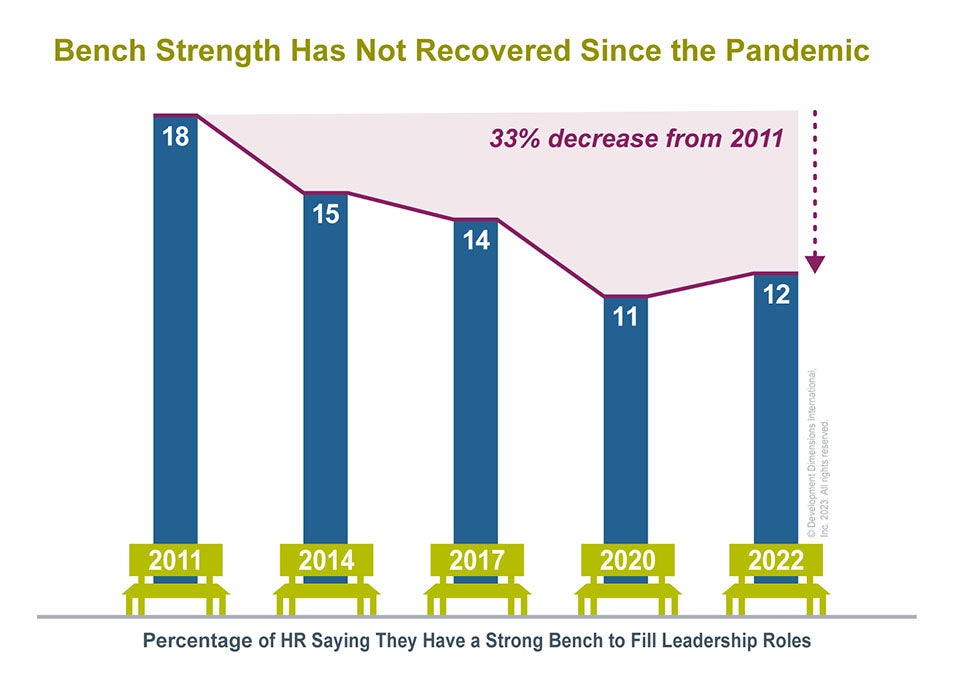“We have…nobody.” I’m hearing this a lot these days from my clients as we start to talk about the strength of their leadership pipelines.
After years of turmoil in the pandemic and the following Great Resignation, most companies I see are feeling battered. As more leaders retire or take off for attractive new opportunities, they feel deeply uncertain about who is really going to step up. And our data shows just how worried people are.

According to DDI’s Global Leadership Forecast, there is a shortage of leaders to fulfill critical roles. Recent survey data also shows that bench strength has not recovered since the pandemic. This year, only 12% of companies report confidence in the strength of their bench. Looking at this data compared to how leaders responded in 2011 shows a 33% decrease. This reveals companies are really struggling in their preparation to fill key leadership positions.
The takeaway? It’s not easy to develop a strong leadership pipeline. It takes a lot of discipline and structure to ensure that you are choosing the right leaders and accelerating their development with purpose toward future roles.
But the companies that are succeeding are the ones that are going to win big in this uncertain economy.
In this piece, I’ll cover some of the challenges I’m seeing among my clients, and more importantly, some of the key practices that separate those that are succeeding and those that are struggling.
What’s Changing About Leadership Pipeline Strategies?
There are some parts about developing your leadership pipeline that are evergreen. In other words, there are tried-and-true strategies that stand the test of time.
But we also have to be aware of what’s changing. The last few years have been about staying afloat. For example, the focus of many HR teams has been on supporting people through constant upheaval. This includes stopping the bleeding of people leaving during the Great Resignation, adjusting to the virtual workplace, and bringing people (reluctantly) back to the office to work hybrid schedules.
Under so much pressure, a lot of foundational leadership succession processes started to slide. Some organizations moved to fewer or no talent reviews, while others didn’t bring people together for development or assessments.
Now, the need for succession planning is much more intense. According to DDI research, 33% of HR say there will be a significant increase in the need to develop internal talent.
Experienced leaders who stayed on through the economic ups and downs are getting ready to retire, with no one to replace them. Meanwhile, younger high-potential leaders are proving that they are more than willing to move on if they don’t see the right career path ahead. This is creating the perfect storm for organizations that are already ill-prepared to fulfill critical leadership roles.
However, there are best practices for developing your pipelines, so your organization has the ready-now leaders at each level required for success. Here are five best practices for building up your company’s bench strength.

#1: Succession starts at the bottom.
Too many companies think of their pipeline very narrowly, considering it only as a succession plan for executives at the top. But that’s short-sighted and doesn’t account for the rapid growth and change nearly every business is facing.
You need to extend your efforts all the way down to the frontline and even emerging leaders. Why? This is where most of your talent is, and these people will move fast. If you don’t spot your high-potential leaders here, you are going to lose them very quickly.
If you don’t get this first step right, you are absolutely not going to have the right leaders higher up in the pipeline. You also have to consider that your development strategy is far more effective if it spans the entire pipeline.
Organizations with high development quality across the pipeline are winning. According to DDI research, organizations with effective development across all leadership levels are significantly more likely to be top financial performers compared to their peers without effective leadership development across their pipeline.

#2: Data must be non-negotiable.
Many companies still rely on leader nominations through the 9-box method to spot potential leadership talent. While this method is scalable, it creates a huge opportunity for bias.
After all, do your managers really know what they are looking for? At this point, it’s no longer acceptable not to have data as part of your talent decision-making processes.
How can organizations get the data they need to make high-quality talent decisions? A leadership skills assessment is a great way for leadership candidates to get data on where they are strong and areas where development may be needed.
With this data on strengths and gaps, organizations can build targeted individual development plans. They can also get data on the inventory of their talent as a whole, to spot both weak and strong areas in their pipelines.

#3: Re-think your definition of potential.
Many companies are reconsidering what it means to be high potential. As they look at their current pipeline, they may be wondering, “Are these really our best?”
Where many organizations go wrong is confusing performance and potential. Many leaders are promoted for their performance, rather than their leadership potential.
For example, without data as the basis, many promotions occur with a manager simply recommending a potential leader. It can go something like this: “I can just tell she’ll be a great leader by the way she handles her team.” But the results a person gets in their current job doesn’t mean they have what it takes to develop into a leader at the next level.
You need to start thinking differently and more broadly in how you define potential. You also need to reinforce that definition across your development efforts.

#4: Plan for diversity across.
Planning for diversity isn’t a surprise to most people at this point. However, many companies are overestimating how far they’ve come, or are taking their eye off the ball.
But there’s a strong case for having diversity in your pipeline. In our Diversity, Equity, and Inclusion Report, we found organizations that financially perform in the top 10% among their peers have significantly more leaders who are women and from minority backgrounds.
However, these numbers are still far below parity. And high-potential pools, which feed the leadership pipeline, are even less diverse. But the organizations that have more diversity in their high-potential pools have high bench strength.
In companies with high bench strength, women made up 28% of their high-potential pools, compared to only 18% in companies with low bench strength. Additionally, in companies with high bench strength, employees from racial and ethnic minorities made up 26% of their high-potential pools, compared to a mere 10% in companies struggling to fill their leadership bench.

#5: Become hyper-focused on leadership behaviors.
Beware of promoting based on talent and performance alone. It’s important not to lose sight of the leadership behaviors people need to be successful.
Many of my clients have shared that they have a very ambitious younger generation who wants to step up into leadership. However, many of these young leaders aren’t thinking about their true motivation to lead others versus simply moving up the ladder. Nor are they thinking about developing the skills that they will need to do so.
There are a wide range of leadership skills that may be needed, but focus first on three critical ones:
- Interpersonal Skills: Everyday interpersonal skills are key to retaining high-potential talent. In fact, 32% of high-potential leaders who say their managers do not have strong interpersonal skills say they intend to leave their companies within the year.
- Coaching: Eighty-five percent of high-potential leaders say they want more coaching—internally and externally—to help them develop. But the quality of coaching matters. Leaders who say their managers are effective coaches are significantly more likely to feel that they have a clear development path, and to feel personally accountable for being an effective leader. They are also 1.5X less likely to say they need to leave their company to advance.
- Building Trust: Leaders need to learn how to build trust in their organization. Less than a third of leaders say they trust senior leaders in their organization. In addition, a lack of trust is also the primary reason that women and leaders from minority backgrounds are leaving their companies.
These skills may seem basic, but they are the ones that leaders need to practice every single day to be effective. And your best leaders will leave if these things aren’t consistently part of your leadership culture. You risk the strength of your entire pipeline without them.
A strong leadership pipeline is the backbone of business success—now and in the future
I started the piece with an admittedly dismal statistic about how few companies feel that they have a strong leadership bench. But it shouldn’t be discouraging. As we see companies place a renewed focus on building their pipeline, they are seeing strong results.
According to DDI’s Global Leadership Forecast research, the companies that do have a strong bench of ready leaders, are also:
- 10X more likely to have employees rate their leader quality as “very good” or “excellent.”
- 6X more likely to be capable of engaging and retaining top talent.
- 5X more likely to be able to prevent employee burnout.
- 3X more likely to be among financially top-performing organizations.
While your pipeline is the foundation of your future, it’s not something that can wait. By implementing these best practices as the strategy for developing your pipeline, I’m certain you’ll start seeing the changes your business needs now.
Diana Powell is a senior leadership strategy advisor for DDI. She has 20 years of experience in leadership and talent management consulting and has developed and deployed business-relevant talent management solutions for many Fortune 500 companies. Diana has a passion for leadership and each leader’s ability to make a difference in the people they connect with.
Topics covered in this blog

